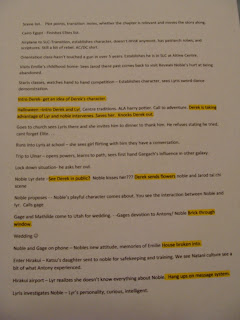You hear it all of the time "write what you know". I'll be the first to agree that for worlds and characters and scenes it is a good idea. However we as humans live BORING lives. I clean the house and kids; referee fights and write stories. There is nothing interesting about me.
I can imagine that for a writer like Stephen King, Robert Ludlum, or Dean Koontz, what they write definitely ISN'T what they live. For Mr. King's sake I certainly hope not.
Anyway, I write Speculative Fiction and the first book in my series is about an assassin. If I wrote what I knew I definitely wouldn't be telling this story. The story consists of a guy, (I am a female) who is a retired military sniper, (never served) turned assassin for a large business. (I am a stay at home mom) He and his wife can't have kids (I have 6) and Travel the world. (my farthest out of the country is Tijuana)
In my book I have my MC do both close hits, and long distance hits, as well as guard people, act as a driver, and steal information.
The key to writing what you don't know is
research and then when some reader points out your wrong going back to the drawing board and rewriting it until it is correct. That isn't to say that such a genre as Speculative Fiction doesn't have some suspension of belief it is a branch of sci/fi. But it has to be believable to a point.
Take my long distance hit for example. My MC has to take out a prisoner that is being transported from a small plane to a helicopter. Why? two reasons. I have to have the opportunity to "hit" him, but also in my mind the prison has a hilo pad but not a runway. But to transport a prisoner from Perth to Canberra is too far of a distance for a chopper. So the plane to chopper thing works. Second a private transfer of a prisoner wouldn't happen in daylight on a well used runway. So the scene is set at four in the morning using a little used runway. So this little used runway ends behind a large hangar constructed of metal struts and sheet metal. (I have seen them in real life), My hubby owns a plane. (definitely a know subject)
My MC situates himself on the top of the hangar where he can see the transfer area. I provide a way to get up. He loosens a panel of metal on the roof the night before and steals a uniform and a "tool" to fix it. If anyone sees him he has a reason to be there. Four in the morning? The day shift didn't get to it? So he sits up there his British .338 sighted in. (my hubby was also a firearms instructor) he sees that the guy is heavily guarded and decides to hit him fast and get out fast. Which he already has that planned. His running clothes are under the "coveralls" and his rifle case is open waiting for him to pop the barrel off and shove it in his pack and run.
He uses a silencer because it is a flash suppressor too. He doesn't have to worry about the sound because no one will hear it over the turning rotors of the chopper and the planes engines as it waits to taxi either to a runway to go back to Perth or to a hangar. He hits him twice, pulls the barrel off the stalk of the rifle shoves it into the case in the pack and repels through the loose panel he created, into the hangar, strips off his coveralls and stuffs them and the rope he stole into the cavity where a plane retracts its landing gear and takes off into the darkness.
I am not an assassin, however, I have shot a rifle and been inside a hangar. What I don't know I plan and research thoroughly, (I draw maps, diagrams, discuss it with others, and research along with other things) and when someone tells me it is wrong I research it again and rewrite.
So. . . While writing what you know is a good thing. For those of us who write what we don't know, careful planning, research and a willingness to fix the errors goes a long way. Well an overly active imagination helps a lot too.










